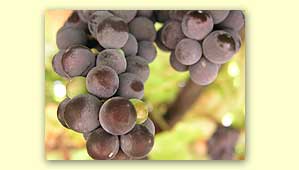 WINE WINE |
 |
|

The history of the vine goes back to the kenozoik period (55 million years ago!) This means, obviously that the vine existed before the first human presence on earth!
After the Glacier Period the vine was mostly found in geographical areas with mild climatologically conditions. Such areas were the Caucasian land , the Mesopotamia and Egypt.
The cultivation started approximately 5.000 years B.C and in Greece it appears 4.000 years B.C.
The Ancient Greeks were considering wine a very signifying part of their lives. They invented Dionysus the God of the wine, the fertility and the theater.
Big festivities were taking place in ancient Greece in order to honor the god Dionysus. |
|
|
In October the festivity was called “Oshoforia ” and athletic games, dances and song Competitions were taking place during the days of the festivity.
In December the festivity was called “Dionisia ” and it was also a major event.
Of the same importance was the festivity taking place in the middle of February, the “Anthestiria ”.
Many social events were associated with the wine in Ancient Greece and above all were the “symposiums”.
The servant responsible for the wine was called “inohoos” and he was an important person amongst the rest of the servants of the house.
|
|
|
Wine apart from its presence to the festivities and the social events was also used for medical reasons, for sacrifices to the name of the Ancient gods and also it was given to a warrior before a battle.
The Ancient Greeks had given names to certain local wines and therefore we had the “Hios Inos” (Wine from the island Hios) the “Thasios inos” (Wine from the island Thasos) and ofcourse Homer talks in his epic poems about the famous “Anthosmious Inos” (Wine with aroma from flowers) which was produced in Corfu .
|
|
|
|
|
The traditional way of extracting must from the grapes was the one done by feet on the wine press. The people who were pressing the graves used to hold a long stick, so as not to loose their balance.
The must was left for the process of brewing into a sack for about five days and the wine produced was either consumed immediately or was stored to earthenware jars for ageing.
It was consumed after 3 or 4 years and it was taking its characteristic aroma and taste with the addition of herbs, fruits or flowers.
The ancient Greeks used to put the resin inside the wine and this has reached until our days. (The famous Greek wine “Retsina” is originated from that ancient wine with the resin put into it). |
|
|
The way of producing wine,in small quantities and in a family manner even in our days is not a lot different than the past times.
Unpilled grapes of reddish color give certain varieties of red wine and pilled light colored grapes give certain varieties of white wine.
There are smaller breweries all over Greece , ran by families and sometimes the wine produced there is of excellent quality.
Famous varieties of wine are produced in Thraki , Macedonia , Ipiros, Central Greece, Peloponisos and at the islands of the Aegian and the Ionian sea .
|
|
|
|
In Corfu , in particular we meet the varieties of Robola (light yellow color and aroma of oranges, caramel and lemon), Fidia, Kotanitis, Skopelitiko, Moshato(Golden Samena with radiant yellow color and aroma of green apple lemon, rose and orange) and Martzavi.
The vine yards which are cultivated in Corfu are the “White Kakotrigis” and the “Red petrokorithos.
Very good white wine is produced in South Corfu and excellent red wine is produced in the Northern area of the island. The vine yards in Corfu cover a space of 15.000.000 square meters .
|
| |
| The toast for happiness and good health in Greek is well known as: “Gia mas”. |
|
| |


